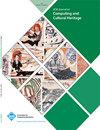Digital Archiving of the Spatial Experience of Cultural Heritage Sites with Ancient Lighting
IF 2.2
3区 计算机科学
Q3 COMPUTER SCIENCE, INTERDISCIPLINARY APPLICATIONS
引用次数: 0
Abstract
Although adaptive reuse has made the preservation, restoration, and maintenance of architectural heritage sites possible due to the revenue generated by the new program, it has unfortunately induced unavoidable renovations that have altered the original design. Consequently, while the physical configuration of an architectural scene of a heritage site can be preserved and restored to mimic how it looked in the past, how to experience it as rendered with the original lighting design that might no longer be available. With the advancement of technologies related to High Dynamic Range Imaging, light models of various ancient illumination can be reconstructed and used as lighting sources for the virtual environment. Although ancient light sources can now be preserved in this digital form, this technique falls short of preserving the real visual perception of the significant canonical scene of cultural heritage with the originally intended lighting. This study proposes a conceptual framework for the digital archiving of the perceptual realism of the original lighting scheme of an architectural heritage site. The Taiwanese folk religion temples were included in a case study to demonstrate the framework; the study investigated how to identify the discrepancy between the scene-based lighting from the past and that of the current period due to adaptive reuse; further, this study determined the systematic method to select the canonical view that can best invoke the memorial spatial experience of the historical space; additionally, this study provides a case report of the restoration of past lighting with candles made with ancient recipes that were recovered from the field study, and the computational process of documenting scene-based lighting with related technologies using high dynamic range imaging. Finally, the researcher of this study conducted two perceptual experiments. The results of the first experiment demonstrated that the pattern of light and dark induced by the daylight falling into the courtyard plays a significant role regarding the viewers’ preference of the canonical scene of the traditional temple. The second experiment further demonstrated canonical views of three temples illuminated with artificial light, modern candlelight, and ancient candlelight, with ancient lighting being the preferred option of viewers.古代照明下文化遗址空间体验的数字化存档
虽然由于新项目带来的收入,适应性再利用使得建筑遗产的保护、修复和维护成为可能,但不幸的是,它引发了不可避免的翻新,改变了原始设计。因此,虽然遗产遗址的建筑场景的物理配置可以被保存和恢复,以模仿它过去的样子,但如何使用原始的照明设计来体验它可能不再可用。随着高动态范围成像相关技术的发展,各种古代照明的光模型可以被重构并作为虚拟环境的光源。虽然古代光源现在可以以这种数字形式保存下来,但这种技术无法保留文化遗产中重要的典型场景的真实视觉感受。本研究提出了一个概念框架,用于对建筑遗址原始照明方案的感知现实主义进行数字存档。以台湾民间宗教寺庙为个案,对该框架进行论证;研究了如何识别由于适应性再利用而导致的过去与当前场景照明之间的差异;在此基础上,确定了选取最能唤起历史空间记忆体验的规范观的系统方法;此外,本研究还提供了一个从实地研究中恢复的古代食谱制作的蜡烛的过去照明的案例报告,以及使用高动态范围成像的相关技术记录基于场景的照明的计算过程。最后,本研究的研究者进行了两个感知实验。第一个实验的结果表明,日光射入庭院所引起的明暗格局对观赏者对传统寺庙正典场景的偏好起着重要作用。第二个实验进一步展示了人工照明、现代烛光照明和古代烛光照明的三座寺庙的经典视图,其中古代照明是观看者的首选。
本文章由计算机程序翻译,如有差异,请以英文原文为准。
求助全文
约1分钟内获得全文
求助全文
来源期刊

ACM Journal on Computing and Cultural Heritage
Arts and Humanities-Conservation
CiteScore
4.60
自引率
8.30%
发文量
90
期刊介绍:
ACM Journal on Computing and Cultural Heritage (JOCCH) publishes papers of significant and lasting value in all areas relating to the use of information and communication technologies (ICT) in support of Cultural Heritage. The journal encourages the submission of manuscripts that demonstrate innovative use of technology for the discovery, analysis, interpretation and presentation of cultural material, as well as manuscripts that illustrate applications in the Cultural Heritage sector that challenge the computational technologies and suggest new research opportunities in computer science.
 求助内容:
求助内容: 应助结果提醒方式:
应助结果提醒方式:


